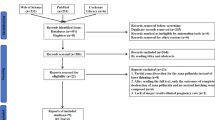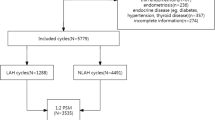Abstract
It is well known that laser-assisted hatching (LAH) is the most popular and ideal embryo hatching technology, but the relevance to pregnancy outcomes of cryopreserved-thawed embryo transfer (ET) is controversial. The purpose of this meta-analysis was to evaluate the effects of LAH on pregnancy outcomes of cryopreserved-thawed ET. We searched for relevant studies published in the PubMed, EMBASE, and Cochrane Central databases up to March 2017. This meta-analysis was primarily used to evaluate the effect of laser-assisted hatching on assisted reproductive outcomes: clinical pregnancy, embryo implantation, multiple pregnancy, miscarriage, and live birth. Using the Mantel-Haenszel fixed effects model and random effects model, we determined the summary odds ratios (OR) with 95% confidence intervals (CIs). There were 12 randomized controlled trials (more than 2574 participants) included in our analysis. The rates of clinical pregnancy (OR = 1.65, 95% CI = 1.24–2.19, I 2 = 49), implantation (OR = 1.59, 95% CI = 1.06–2.38, I 2 = 82%), multiple pregnancy (OR = 2.30, 95% CI = 1.30–4.07, I 2 = 33%), miscarriage (OR = 0.86, 95% CI = 0.50–1.48, I 2 = 0%), and live birth (OR = 1.09, 95% CI = 0.77–1.54, I 2 = 0%) revealed comparable results for both groups. In summary, this meta-analysis demonstrates that LAH is related to a higher clinical pregnancy rate, embryo implantation rate, and multiple pregnancy rate in women with cryopreserved-thawed embryos. However, LAH is unlikely to increase live birth rates and miscarriage rates. Due to the small sample evaluated in the pool of included studies, large-scale, prospective, randomized, controlled trials are required to determine if these small effects are clinically relevant.











Similar content being viewed by others
References
Petersen CG, Mauri AL, Razera R, Baruffi L (2006) Laser-assisted hatching of cryopreserved-thawed embryos by thinning one quarter of the zona. Reprod BioMed Online 13(5):668–675
Andersen AN et al (2008) Assisted reproductive technology in Europe. Hum Reprod 23:756–771
Cohen J (2007) Manipulating embryo development. In Human Preimplantation Embryo Selection. Informa Healthcare, Informa UK Ltd., Abingdon UK
Wang EH et al (2016) Outcomes of vitrified-warmed cleavage-stage embryo hatching after in vitro laser-assisted zona pellucida thinning in patients. Biomedical Reports 5:376–382
Kanyo K et al (2016) The impact of laser-assisted hatching on the outcome of frozen human embryo transfer cycles. Zygote 24(5):742–747
Wan CY et al (2014) Laser-assisted hatching improves clinical outcomes of vitrified-warmed blastocysts developed from low-grade cleavage-stage embryos: a prospective randomized study. Reprod BioMed Online 28(5):582–589
Laufer N et al (1993) The efficacy and safety of zona pellucida drilling with a 193-nm excimer laser. Fertil Steril 59:889–895
Tadir Y et al (1993) Laser for gamete micromanipulation: basic concepts. J Assist Reprod Genet 10:121–125
Strohmer H, Feichtinger W (1992) Successful clinical application of laser for micromanipulation in an in vitro fertilization program. Fertil Steril 58:212–214
Martins WP et al (2011) Assisted hatching of human embryos: a systematic review and meta-analysis of randomized controlled trials. Hum Reprod Update 17:438–453
Hammadeh ME, Fischer-Hammadeh C, Ali KR (2011) Assisted hatching in assisted reproduction: a state of the art. J Assist Reprod Genet 28:119–128
Lanzendorf SE et al (2007) A randomized, prospective study comparing laser-assisted hatching and assisted hatching using acidified medium. Fertil Steril 87(6):1450–1457
Blake DA et al (2001) Laser zona pellucida thinning—an alternative approach to assisted hatching. Hum Reprod 16:1959–1964
Deeks, J.J., J. P. Higgins, and D. G. Altman (2011) Chapter 8:assessing risk of bias in included studies,” in Cochrane Handbook for Systematic Reviews of Interventions Version 5.1.0. In: J Higgins, S Green (Eds) The Cochrane Collaboration. http://www.cochrane-handbook.org
Elhelw, B., M.M. El Sadek., and K.M. Al Nomrosy (2005) Laser assisted hatching may enhance implantation and pregnancy rates on cryopreservedthawed embryos in patients with repeated implantation failures. A prospective randomised study. ESHRE Copenhagen - poster abstract
Nagy ZP et al (1999) Laser-assisted hatching and removal of degenerated blastomere(s) of frozen-thawed embryos improves pregnancy rate [abstract]. Fertil Steril 72(3 Suppl 1):S4
Ge HS et al (2008) Impact of assisted hatching on fresh and frozen-thawed embryo transfer cycles: a prospective, randomized study. Reprod BioMed Online 16(4):589–596
Cohen J et al (1992) Implantation enhancement by selective assisted hatching using zona drilling of human embryos with poor prognosis. Hum Reprod 7:685–691
Mandelbaum J (1996) The effects of assisted hatching on the hatching process and implantation. Hum Reprod 11:43–50
Schiewe M et al (1995a) Enzymatic characterization of zona pellucida hardening in human eggs and embryos. J Assist Reprod Genet 12:2–7
Ng EH et al (2005) A randomized double-blind controlled study of the efficacy of laser-assisted hatching on implantation and pregnancy rates of frozen-thawed embryo transfer at the cleavage stage. Hum Reprod 20(4):979–985
De Felici M, Siracusa G (1982) ‘Spontaneous’ hardening of the zona pellucida of mouse oocytes during in-vitro culture. Gamete Research 6:107–113
Carroll J, Depypere H, Matthews CD (1990) Freeze-thaw-induced changes of the zona pellucida explains decreased rates of fertilization in frozen-thawed mouse oocytes. J Reprod Fertil 90:547–553
Liu HC, Cohen J, Alikani M (1993) Assisted hatching facilitates earlier implantation. Fertil Steril 60:871–875
Schiewe MC et al (1995) Physiological characterization of blastocyst hatching mechanisms by use of a mouse antihatching model. Fertil Steril 63:288–294
Develioglu OH, Hsiu JG, Nikas G (1999) Endometrial estrogen and progesterone receptor and pinopode expression in stimulated cycles of oocyte donors. Fertil Steril 71:1040–1047
Nikas G et al (1999) Endometrial pinopodes indicate a shift in the window of receptivity in IVF cycles. Hum Reprod 14:787–792
Valojerdi MR et al (2008) Effect of laser zona pellucida opening on clinical outcome of assisted reproduction technology in patients with advanced female age, recurrent implantation failure, or frozen-thawed embryos. Fertil Steril 90(1):84–91
Balaban B et al (2006) Laser-assisted hatching increases pregnancy and implantation rates in cryopreserved embryos that were allowed to cleave in vitro after thawing: a prospective randomized study. Hum Reprod 21(8):2136–2140
Debrock S et al (2011) The effect of modified quarter laser-assisted zona thinning on the implantation rate per embryo in frozen/vitrified-thawed/warmed embryo transfer cycles: a prospective randomized controlled trial. Hum Reprod 26(8):1997–2007
Hebisha SA et al (2015) Does laser assisted hatching on thawed embryo after vitrification improve implantation rate? Fertil Steril 104(3):e305–e306
Lu XM et al (2016) Effect of laser-assisted hactching on outcome of frozen-thawed embryo transfer for patients with previous repeated implantation failure. Academic Journal of the Second Military Medical University 37(1):106–110
De Croo I et al (2013) Prospective, randomized trial on the effect of laser assisted hatching on frozen-thawed embryo transfer cycles. Fertil Steril 100(3):S16
Hiraoka K et al (2009) Impact of the size of zona pellucida thinning area on vitrified-warmed cleavage-stage embryo transfers: a prospective, randomized study. J Assist Reprod Genet 26(9–10):515–521
Zhang XJ et al (2009) Effect of the size of zona pellicuda thinning by laser assisted hatching on clinical outcome of human frozen-thawed enbryo transfers. CryoLetters 30(6):455–461
Tadin I et al (2002) Fetal reduction in multifetal pregnancy—ethical dilemmas. Yonsei Med J 43:252–258
Das, S., et al. (2009) Assisted hatching on assisted conception (IVF and ICSI). Cochrane Database Syst Rev p CD001894
Germond M et al (1995) Microdissection of mouse and human zona pellucida of the procedure. Fertil Steril 64:604–611
Author information
Authors and Affiliations
Corresponding author
Rights and permissions
About this article
Cite this article
Zeng, M., Su, S. & Li, L. The effect of laser-assisted hatching on pregnancy outcomes of cryopreserved-thawed embryo transfer: a meta-analysis of randomized controlled trials. Lasers Med Sci 33, 655–666 (2018). https://doi.org/10.1007/s10103-017-2372-x
Received:
Accepted:
Published:
Issue Date:
DOI: https://doi.org/10.1007/s10103-017-2372-x




